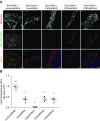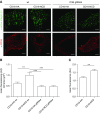Nephrin Signaling Results in Integrin β 1 Activation
- PMID: 31097607
- PMCID: PMC6551783
- DOI: 10.1681/ASN.2018040362
Nephrin Signaling Results in Integrin β 1 Activation
Abstract
Background: Patients with certain mutations in the gene encoding the slit diaphragm protein Nephrin fail to develop functional slit diaphragms and display severe proteinuria. Many adult-onset glomerulopathies also feature alterations in Nephrin expression and function. Nephrin signals from the podocyte slit diaphragm to the Actin cytoskeleton by recruiting proteins that can interact with C3G, a guanine nucleotide exchange factor of the small GTPase Rap1. Because Rap activity affects formation of focal adhesions, we hypothesized that Nephrin transmits signals to the Integrin receptor complex, which mediates podocyte adhesion to the extracellular matrix.
Methods: To investigate Nephrin's role in transmitting signals to the Integrin receptor complex, we conducted genetic studies in Drosophila nephrocytes and validated findings from Drosophila in a cultured human podocyte model.
Results: Drosophila nephrocytes form a slit diaphragm-like filtration barrier and express the Nephrin ortholog Sticks and stones (Sns). A genetic screen identified c3g as necessary for nephrocyte function. In vivo, nephrocyte-specific gene silencing of sns or c3g compromised nephrocyte filtration and caused nephrocyte diaphragm defects. Nephrocytes with impaired Sns or C3G expression displayed an altered localization of Integrin and the Integrin-associated protein Talin. Furthermore, gene silencing of c3g partly rescued nephrocyte diaphragm defects of an sns overexpression phenotype, pointing to genetic interaction of sns and c3g in nephrocytes. We also found that activated Nephrin recruited phosphorylated C3G and resulted in activation of Integrin β1 in cultured podocytes.
Conclusions: Our findings suggest that Nephrin can mediate a signaling pathway that results in activation of Integrin β1 at focal adhesions, which may affect podocyte attachment to the extracellular matrix.
Keywords: cytoskeleton; nephrin; renal cell biology; signaling.
Copyright © 2019 by the American Society of Nephrology.
Figures









References
-
- Pavenstädt H, Kriz W, Kretzler M: Cell biology of the glomerular podocyte. Physiol Rev 83: 253–307, 2003 - PubMed
-
- Wiggins RC: The spectrum of podocytopathies: A unifying view of glomerular diseases. Kidney Int 71: 1205–1214, 2007 - PubMed
-
- Faul C, Asanuma K, Yanagida-Asanuma E, Kim K, Mundel P: Actin up: Regulation of podocyte structure and function by components of the actin cytoskeleton. Trends Cell Biol 17: 428–437, 2007 - PubMed
Publication types
MeSH terms
Substances
LinkOut - more resources
Full Text Sources
Medical
Molecular Biology Databases
Research Materials

